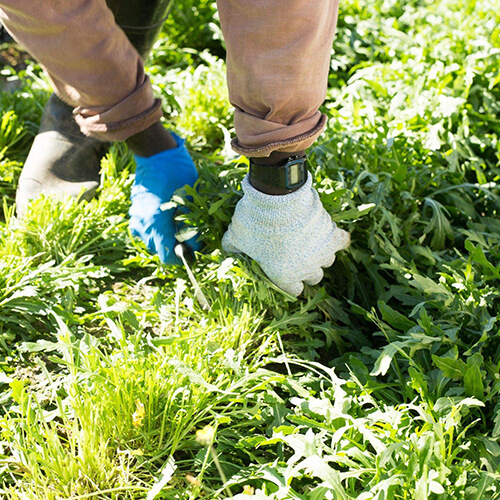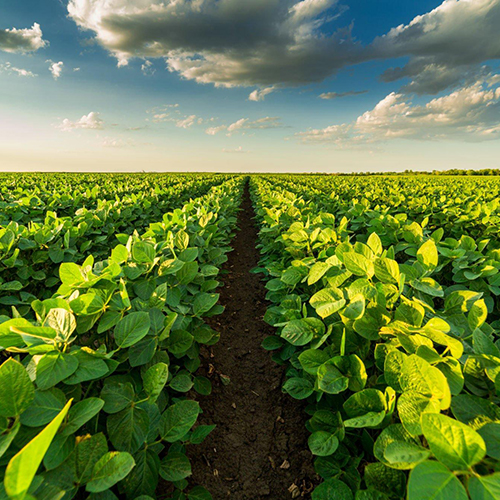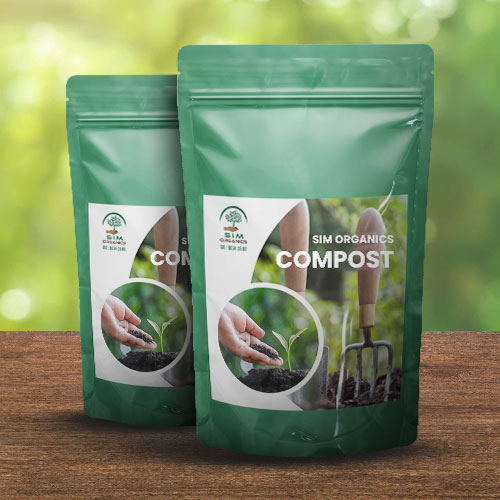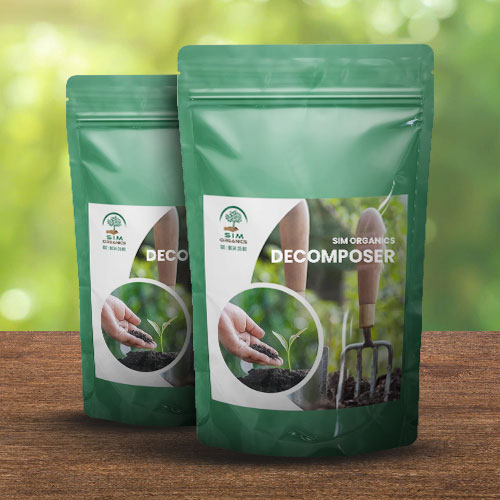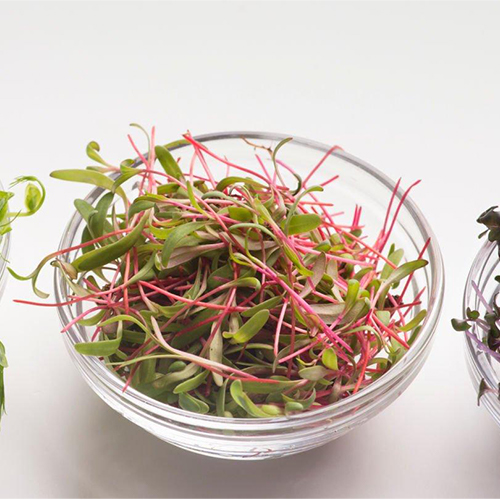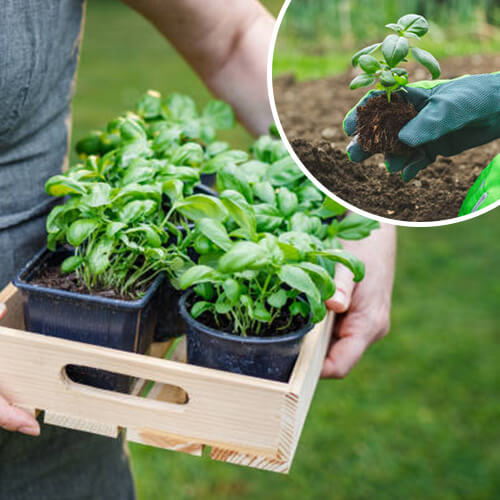
At Sim Organics, we are thrilled to guide you through the captivating world of herb gardening. Embark on a journey that awakens your senses and elevates your culinary creations. Whether you are a seasoned gardener or a budding plant whisperer, these herb planting instructions will help you cultivate a thriving and aromatic herb garden that’s both beautiful and bountiful.
BASIL – (55 Days to Maturity)
Delight in the fragrant charm of basil as it graces your garden and kitchen with its vibrant presence. Plant basil seeds indoors in late spring or during the summer months. As the seedlings emerge, thin them to maintain a distance of 1 foot between plants. Remember, basil is sensitive to frost and cold, so ensure its protection. To nurture its health, water in the mid-day sun rather than the evening, and take care to prevent overwatering, which can lead to mildew. Regularly pinch off seed heads to encourage robust growth and prevent premature seeding.
BORAGE – (50 – 60 Days to Maturity)
Elevate your garden with the regal beauty of borage, a versatile herb that thrives in spring’s embrace. Sow borage seeds 1/8 inch deep, offering them 12 inches of space to flourish. This herb prefers fine, well-worked moist soil and partial sun. Witness the captivating bloom of borage throughout the season, and anticipate its self-seeding grace for years to come. To support top-heavy plants, consider planting in thick clumps and providing additional support when needed. Embrace the essence of spring and summer by picking the leaves as flowering begins.
CARAWAY – (60 Days to Maturity)
Unleash the aromatic allure of caraway in your garden, a versatile herb with a spectrum of uses. Directly sow caraway seeds outdoors in the warm embrace of May to June. Plant them 1/8 inch deep, spaced 12 inches apart. Ensure the seeds are barely covered and maintain consistent moisture until germination. As seedlings emerge, thin them as necessary to ensure optimal growth and development.
CURLED CRESS – (55 – 70 Days to Maturity)
Dive into the world of curled cress, a dynamic herb that brings a distinctive flair to your garden and culinary endeavors. Sow garden cress and curled cress seeds ¼ inch deep, embracing the lush growth that comes from thick rows. Thin out successful seedlings to 6 inches apart, while maintaining rows spaced 18 to 24 inches apart. Engage in successive sowings every 10 to 14 days to ensure a continual harvest. Don’t forget to pinch back cress to manage its exuberant growth.
CORIANDER/CILANTRO – (25 – 55 Days to Maturity)
Embark on a journey of flavor and aroma with coriander/cilantro, a herb that adds a unique twist to your culinary creations. Sow seeds directly into the garden 1/2 inch deep, providing 5-8 inches of space between them after the frost’s threat has passed. Exercise care with weeding and mulching in the early season. As the leaves and flowers transition to brown, indicating maturity, harvest the plant promptly. Dry the seeds in preparation for storage, preserving their essence for your culinary adventures.
DILL – (40 – 60 Days to Maturity)
Experience the charm of dill as it graces your garden with its feathery foliage and distinctive flavor. Plant dill early in the spring after the risk of frost has diminished. Sow seeds directly 1/4 inch deep, spacing them approximately 10 inches apart. Embrace dill’s preference for full sun and well-drained, moist soil. Regularly snip the leaves for culinary use and, as the seed heads turn beige, harvest the top half of the plant. Dry the harvest for future enjoyment.
FENNEL – (75 Days to Maturity)
Infuse your garden with the graceful elegance of fennel, a herb that flourishes in well-drained soil and full sun. Sow fennel seeds 1/8 inch deep, providing ample space of 6 to 12 inches between plants. Keep the soil consistently moist for the first 2 weeks, ensuring the emergence of the first leaves. Be cautious not to overwater as the herb matures.
PARSLEY – (70 – 80 Days to Maturity)
Elevate your culinary creations with the freshness of parsley, a versatile herb that’s a staple in many dishes. Sow parsley seeds outdoors in spring, pushing them 1/2 inch deep into the soil and covering them with a gentle layer of earth. Maintain a spacing of about 3 inches between seedlings to ensure their proper growth. Keep the soil consistently moist to support germination. For an extended harvest, consider sowing parsley seeds indoors in late winter and transitioning them outdoors in early spring, just before the last frost.
SUMMER SAVORY – (60 Days to Maturity)
Explore the subtle nuances of summer savory as it graces your garden with its delicate charm. Start with fresh seeds, sowing them directly into the ground or in flats, no more than 1/8 inch deep. Create a spacing of 10 inches between plants, and embrace successive sowings throughout spring until mid-summer. Provide additional support if the plants lean, ensuring they thrive in their journey toward maturity.
Tomatoes: A Patient Fermentation
Saving tomato seeds requires a touch of patience, but the rewards are abundant. Begin by harvesting ripe tomatoes from various vines of the same variety. Cut the tomatoes in half and gently squeeze them into a bowl, revealing the gelatinous coating that encapsulates each seed. This natural barrier prevents the seeds from sprouting within the tomato.
To liberate these seeds and prepare them for future growth, a simple fermentation process is your ally. Add approximately half the volume of water as there are seeds and juice in the bowl. Stir the mixture twice daily for around three days, maintaining a watchful eye—fermentation speeds up in warmer conditions.
As the mixture transforms, a delicate mantle of white or gray mold may grace its surface. Fear not, this is a natural part of the process. Once bubbles rise to the top or a substantial coat of mold forms, halt the fermentation by doubling the mixture with water and stirring vigorously. The good, clean seeds will settle at the bottom.
Gently pour off any mold, debris, and floating seeds (which are hollow). Repeat the process, adding more water until only pristine seeds remain. Strain the mixture through a sieve, then gently spread the seeds on a glass or ceramic plate for drying. Stir twice daily to prevent clumping and ensure even drying. Note, however, that tomato seeds have a propensity to germinate if not dried swiftly. Avoid sunlight or ovens for drying, and consider using a fan to expedite the process.
Peppers: A Simple Harvest
Peppers offer an uncomplicated route to seed saving. Once the peppers change color, indicating full ripeness, cut them open and extract the seeds onto a plate. Preserve the flesh for culinary endeavors. Allow the seeds to dry in a non-humid, shaded space. Test their readiness periodically until they break rather than bend—a clear indication that they are ready for storage. Utilize a glass or ceramic plate for this purpose, stirring twice daily to prevent clumping.
Harvesting Nature’s Treasures: A Guide to Seed Saving
As your garden bursts with the vibrant abundance of melons, squash, and other delectable delights, it’s time to delve into the art of seed saving. Preserving the essence of your harvest ensures a bountiful future, and at Sim Organics, we’re here to guide you through the journey with ease and expertise.
MELONS AND SQUASH: A Simple Harvest
Whether you’re relishing the juicy sweetness of muskmelons, the refreshing allure of watermelons, or the hearty goodness of winter squash, seed saving is a breeze. For muskmelons, cut the fruit open and scoop the seeds into a strainer. Give them a gentle rinse, and then allow them to dry. Watermelons follow suit with a slight twist. Place the seeds in a strainer, adding a dash of dishwashing liquid to remove any residual sugars. Rinse the seeds thoroughly, and let them dry.
With winter squashes, a delicate touch is essential. Cut the squash to expose the seed cavity, ensuring you don’t sever any seeds in the process. Carefully pull the seeds away from the fibers, rinse them, and set them out to dry. Remember, you can save seeds from most winter squashes months after harvesting, although long-storage varieties might show signs of sprouting after around 6 months.
SEEDS THAT REQUIRE PATIENCE:
Certain seeds, like those from eggplants, cucumbers, and summer squashes, demand a bit more patience and ripening before they’re ready for saving. For eggplants, allow the fruits to reach a stage far beyond their typical table-ready state. Ripe eggplants will appear dull, off-colored, and firm, sometimes even shriveled. Cut them in half and remove the flesh from the seeded areas. For larger seed quantities, utilize a food processor or blender to mash the flesh and reveal the seeds. Process the pulp (without peeling), add water, and allow the seeds to settle. Rinse and repeat until only clean seeds remain. Strain the mixture through a fine-mesh strainer, dry, and enjoy the rewards of your patience.
Cucumbers, when ripe, change in color and texture, becoming soft. Once they’ve reached this stage, cut them open, scrape out the seeds, and embark on the process of cleaning and drying.
Summer squashes, too, must mature past their tender phase. When the squash resists a fingernail’s pressure, it’s ripe for seed saving. Cut it open, extract the seeds, and prepare them for the drying process.
COLLECTING THE LIKES OF BEANS, PEAS, AND CORN
Beans and peas offer a simple yet rewarding journey into seed saving. Wait until the pods are fully ripened, indicated by their dry and crackly texture on the vine. They’ll also emit a satisfying rattle as the seeds inside mature. Once collected, spread the pods in a well-ventilated area for at least two weeks, allowing them to dry thoroughly before shelling.
As you embrace the art of seed saving, you’re engaging in a time-honored tradition that bridges the gap between seasons and generations. Each seed you preserve becomes a testament to your stewardship of the earth’s bounty. At Sim Organics, we celebrate your commitment to nurturing nature’s legacy, one seed at a time.
Are you looking for a lifestyle change for good health?
Sim Organics, a pioneer in its own right, is paving the way for nature lovers like you. We offer biofertilizers, organic garden essentials like premium soil mix, and can assist you in designing the perfect garden space to suit your unique needs.
For a consultation, contact us at +91 78801 66671 or email us at contact@simorganics.net.
Our solutions are also ideal for larger farmlands.

